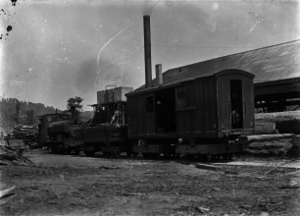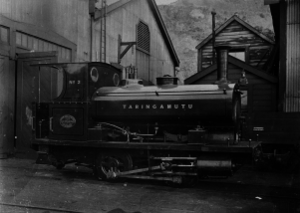Taringamotu Tramway
| Taringamotu Tramway | |||||||||||||||||||||||||||||||||||||||||
|---|---|---|---|---|---|---|---|---|---|---|---|---|---|---|---|---|---|---|---|---|---|---|---|---|---|---|---|---|---|---|---|---|---|---|---|---|---|---|---|---|---|
|
The Taringamotu Express at Oruaiwi, 1922
| |||||||||||||||||||||||||||||||||||||||||
|
Barclay steam locomotive for the Taringamutu
(sic) Totara Sawmill Company, 1910 | |||||||||||||||||||||||||||||||||||||||||
| Gauge : | 3½ feet = 1067 mm | ||||||||||||||||||||||||||||||||||||||||
|
|||||||||||||||||||||||||||||||||||||||||
The Taringamotu Tramway , nicknamed the Taringamotu Express , was a forest railway at Oruaiwi , also called Waituhi , a settlement in the Taringamotu River valley in the Manawatu-Wanganui region of New Zealand's North Island .
history
The forest railway with a gauge of 3½ feet (1067 mm) was in operation from about 1910 to the mid-1960s. After 1956 it only operated between the NZR station and the Taringamotu Totara Sawmill Company, which was in operation from 1907 to 1956. It was built sufficiently stable for the NZR to allow its wagons to be used on the forest railway. The Railway Enthusiasts Society of Auckland excursions stopped at the NZR siding on various occasions to ride the forest railway. The previous route can still be easily made out in the terrain up to the sawmill, but above the sawmill it is difficult to see.
bridges
Most of the trestle bridges were measured and built by Frank Ward (* 1873 in Manchester ; † June 2, 1956). Though he was short in stature and looked a bit weak, his strength at swinging an ax was remarkable. He worked mostly as a loner when he built the Trestle bridges before the loggers cut down the trees and to the track moved from where they with the steam locomotive on Barks lost were brought to the forest railway to the sawmill. He had to carve the uprights and cross members by hand from solid Totara logs. He trimmed the uprights and cut the cross members into a rectangular shape with a broad ax , which had a much wider blade than a normal ax.
His masterpiece was a 32 meter high and 91 meter long double-decker wooden viaduct. It actually consisted of two bridges in one. The lower floor was 15 m high and the upper floor another 17 m. Frank Ward selected the best totara trees for the stands and claimed them end-to-end to a uniform thickness of 18 inches (460 mm), starting at the bottom. He tempered the edges of the sap so that very high strength was achieved while maintaining the natural strength of the grain of each tree. He only used a hand saw, mallets, axes, wedges, files, marker cords and chalk to mark the lines. The only machines he used were a hand winch and a Vulcan steam cable winch called Ward's Hauler , which he operated exclusively himself.
Accidents
On the afternoon of September 3, 1912, around 4:00 p.m., a group of people drove on the forest railway through the bush of the Taringamotu Sawmilling Company. At the lower end of a steep section, some wild boars ran across the railroad track, which could not get to safety in time, so that there was a collision in which a freight wagon loaded with passengers overturned. Some of the passengers were able to jump off, but the young ark, who was around 20 years old, died before reaching the hospital. He was from Scotsdale , Tasmania , where his parents were still living at the time of the accident. Pastor Hanby suffered a broken leg, a sprained ankle and severe bruises to his chest. Sister Macfarlane, who was on the train at the time of the accident, provided first aid until medical attention was available. The injured people were brought to Frankton by express train on the main line. Lade died on the train at 1:12 a.m.
Another fatal accident occurred on January 22, 1915. A train with an open freight car and a closed passenger car drove from Taringamotu to Waituhi that morning. According to a contemporary newspaper article, a number of Māoris traveled in the gondola, while the Pākehās traveled in the closed car. Apparently the train derailed causing the wagons to tip over, killing one Māori child and seriously injuring another, and injuring two Māori women in their legs and one in their arm. Fortunately, the closed car offered the Pākehās better protection so that they were not injured.
Locomotives
The Taringamotu Totara Sawmill Company owned a total of four steam locomotives and several draisines , which were colloquially called jiggers. In 1908 the company purchased a used Barclay 0-4-0 saddle tank steam locomotive that had been built in 1878. It worked at a steam pressure of 12 bar and had cylinders with a bore of 10¼ "(260 mm), which were bored out to 10½" (270 mm) during a major overhaul. In 1912, the boiler was replaced with a new boiler specially made by A. & G. Price, which remained in service until the locomotive was decommissioned in 1951.
Web links
Individual evidence
- ↑ Wilson Lythgoe: Once upon a time, long ago, The Main Trunk in a Day! or, more correctly, Puketutu to Manunui sometime in early 1972. Retrieved May 8, 2018.
- ↑ Carolyn M. King, D. John Gaukrodger and Neville A. Ritchie: The Drama of Conservation: The History of Pureora Forest, New Zealand. Springer, 2015, p. 103. Retrieved May 8, 2018.
- ↑ Wheel5800: Taringamotu tram. Photos from February 24, 2011 on Flickr. Retrieved May 8, 2018.
- ↑ Bush trams and other log transport. Goodbye to the bush. Retrieved May 8, 2018.
- ^ A b Ken Anderson and Ron Cooke: Tringamoot: The story of Taringamutu Totara Sawmills Ltd in the Taringamotu Valley. Published by Taumarunui & Districts Historical Society Inc, 2014, ISBN 9780992259020 . Retrieved May 8, 2018.
- ↑ Press Association: Taringamotu truck accident. Wild pigs on the line. Poverty Bay Herald, Sept. 4, 1912, page 6. Retrieved May 8, 2018.
- ^ Press Association: Railway Smash: Child killed. Northern Advocate, Jan 22, 1915, p. 5. Retrieved May 8, 2018.
Coordinates: 38 ° 49 '24.6 " S , 175 ° 26" 43.1 " E






